neurobiology and behaviour Notes
Neurobiology and behaviour
Approaching the topic
- Understanding the concepts
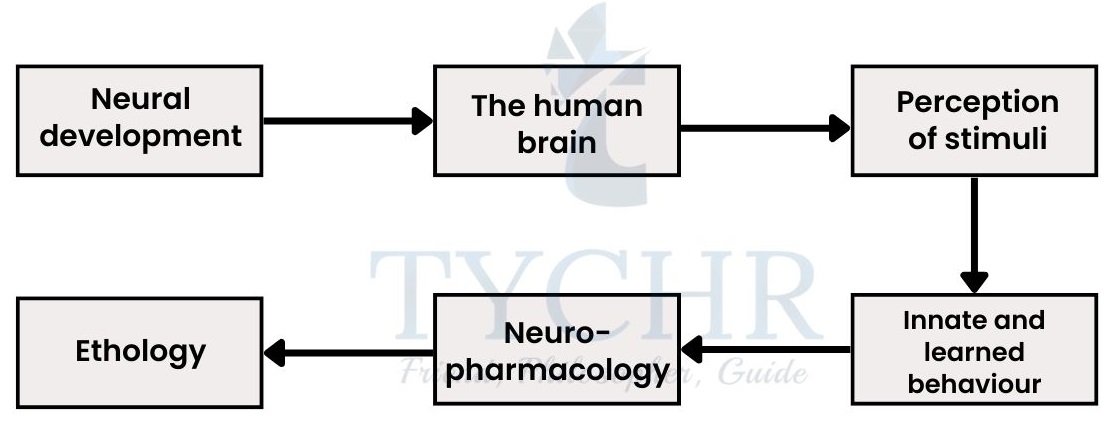
- Application of these concepts
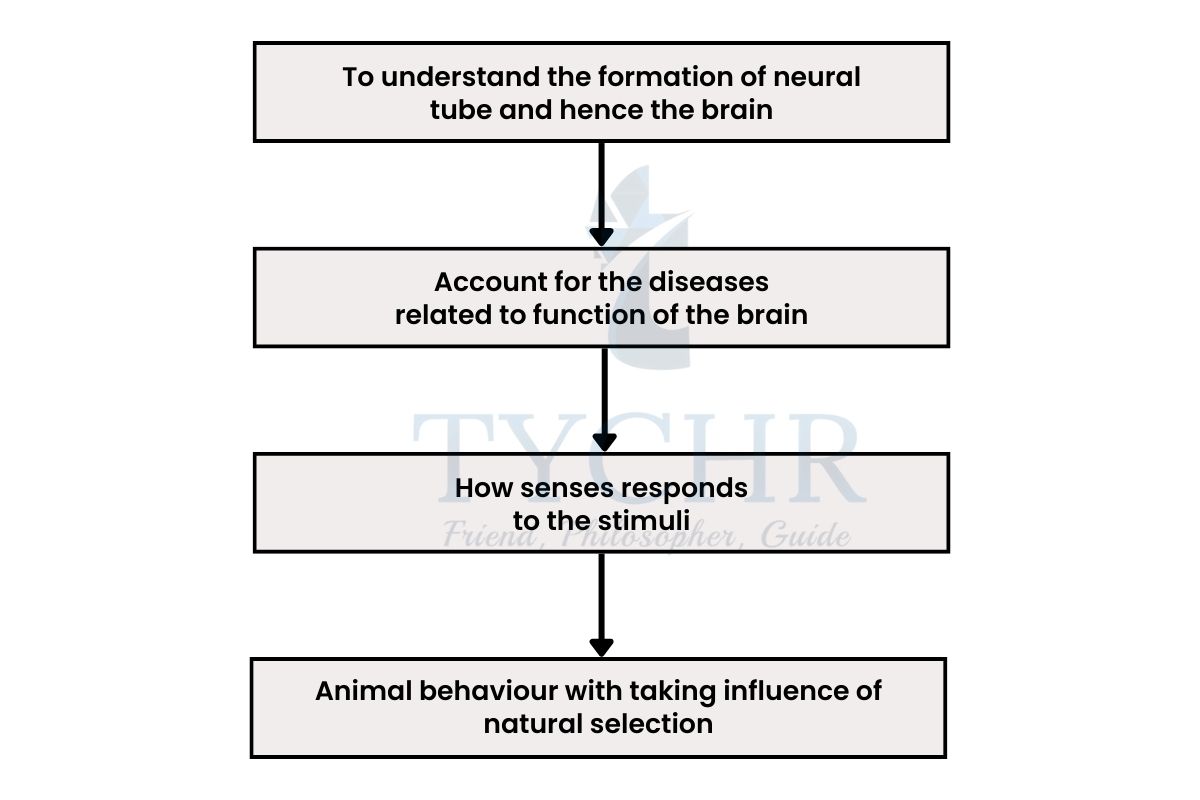
Basic terms to ponder:
- Neurobiology: The study of the complex information processing system that includes the brain and the nervous system is called neurobiology.
- Nerve cell: Also called as neurons, the excitable cell which performs communication in the whole nervous system.
- Nerve fibers: A thread-like myelinated structure (unit) of the neuron cell.
- Neuroglia or glial cells: These are the neuron supporting cells.
- Neurogenesis: The process of formation of new neurons by differential method.
- Autopsy: This method is also used for studying the brain, by cutting the brain through surgical procedures, after the death of the individual.
- Embryogenesis: The study of the process of development of an embryo into a newborn.
- Nervous system: A highly coordinated organ with the weight of 2 Kg, which makes it possible for an organism to provide the response to involuntary and voluntary actions inside or outside the body, by the channelling of its basic unit, the neurons.
- CNS (Central Nervous System): Consists of brain and spinal cord, stimulate muscles to contract and glands to secrete.
- PNS (Peripheral Nervous System) : Consists of all the nervous tissue except brain and spinal It is divided into:
ANS (Autonomic Nervous System):- Responses involuntarily from visceral organs to CNS and from CNS to visceral organs.
SNS (Somatic Nervous System):- Responses voluntarily by conveying messages to and from the CNS.
ENS (Enteric Nervous System):- “Brain of the gut”, performs involuntary responses with over 100 million neurons - fMRI: Functional magnetic resonance imaging (fMRI) is the technique by which the blood flow can be determined inside the brain. This method produces a continuous film by showing another picture every second. This method is used for medical purposes like before performing surgery, treatment for a stroke etc.
- Angelman’s syndrome: It is genetically inherited disorder of the nervous system, which causes developmental delays in babies (6-12 months old). Diagnosed by electroencephalogram (EEG) patterns.
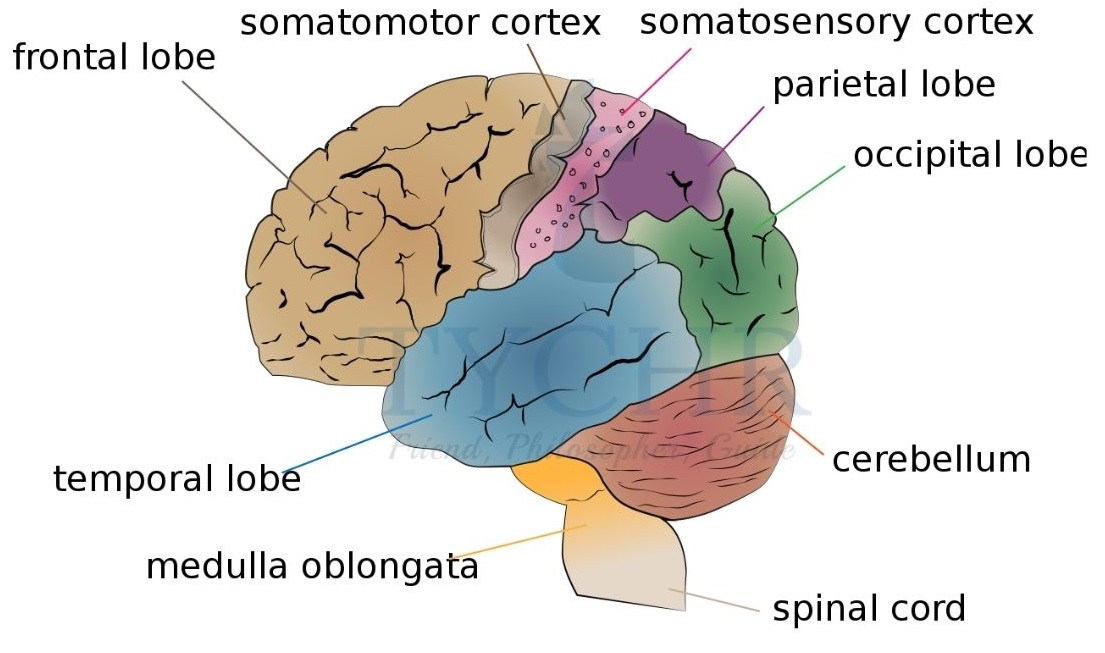
Neural Development
Formation of neural tube
- It is the very first organ to develop in an embryo.
- Embryo develops three distinct tissue layers
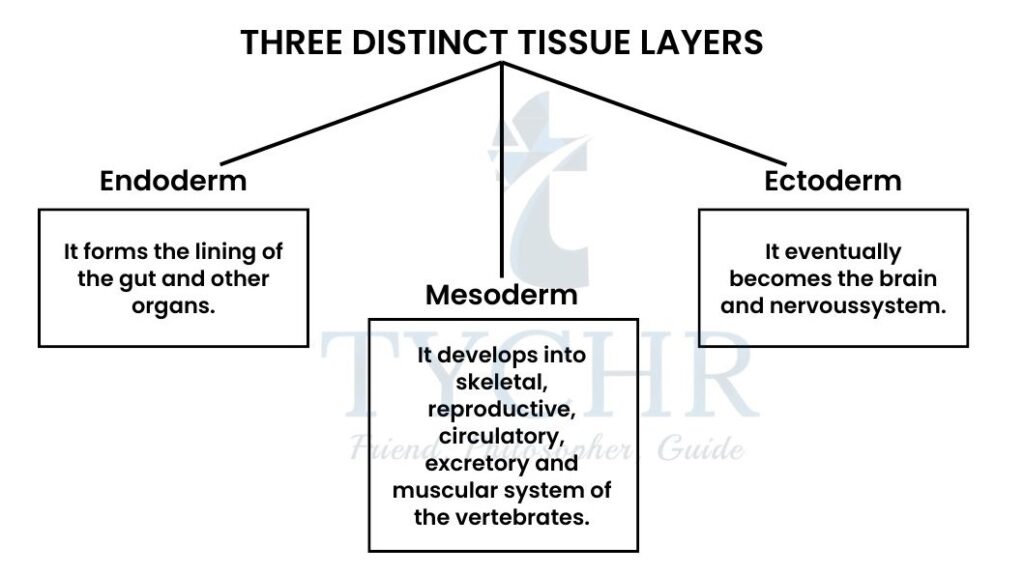
- At first, notochord is formed (by mesodermal tissue) which, by mutual connection with ectodermal tissue, causes it to develop a neural plate (made of columnar cells) with a neural fold. This neural fold closes, compacts and forms a neural tube. The neural tube forms the brain and spinal cord, as the embryogenesis continues.
- In the centre of these three germinal layers a cavity called archenteron is present.
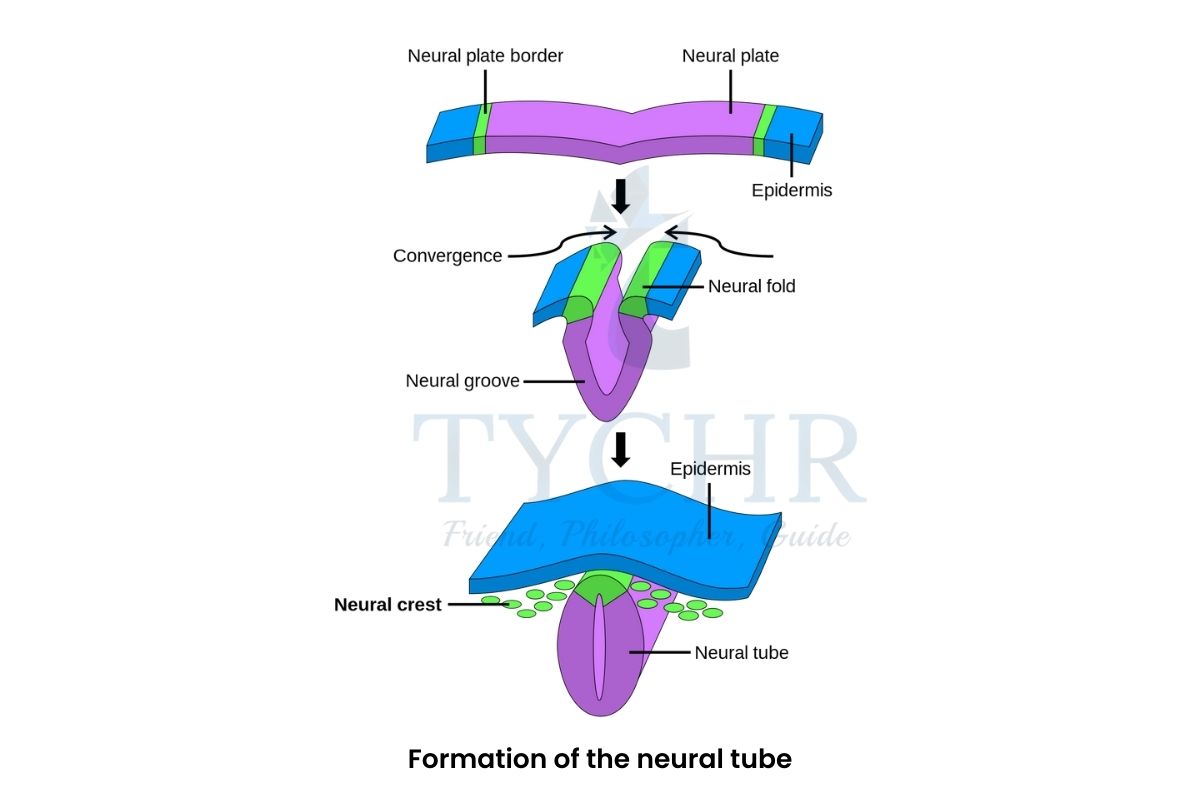
Figure 12.1 Formation of the neural tube - The neural fold makes the closure of the neural tube, which occurs faster at the upper side of the caudal region towards the brain than the lower side. The failure of this closure at or before 27th day of the development will lead to a condition called spina bifida. This is a severe condition with improper development of the neural tube.
- As the neural tube develops further, two types of cells begin to differentiate, named
neurons (carry messages) and glial cells (do not carry messages).
Neurogenesis
- The process of formation or synthesis of neurons by differentiation of the neuroblast cell is called neurogenesis.

- Originate in neural tubes only.
- The simultaneously differentiating glial cells (constitute 90% of the brain cells) perform many functions like providing scaffolding and nutritional support to the neuron.
- Axon of the neuron grows on the scaffolding structure of glial cells and has the capacity to move forward at about 1mm a day.
Neurone development
Mechanism of elongation of the axon of the neuron
- A growth cone is present at the tip of the axon which directs it. Target cells are present at the final position of the neurons which produce chemical messages, to which the neuron responds by forming the synapse. The receptor to the chemical produced by target cells is present at the growth cone of the axon, so that the chemical messaging takes place within the neuron.
- Certain molecules like cell adhesion molecule (CAM) can act as signals to growth cone for further growth. These CAMs are present in the growth environment of the axon and when they come in contact with the CAM-specific receptor of the growth cone, they recognise each other and chemical messaging takes place that results in elongation of the axon towards the muscles from the spinal cord.
- Axon can grow a lot beyond the neural tube like motor neurons (longest neurons in the body).
Multiple synapses are formed during early brain development. It occurs to find the best fit of the neuron, with the neuron. Because lots and lots of neurons develop at that stage and the matching of the specific types of neurons with each other is done to have a working connection. The formed functional synapse out of thousands retains and the rest gradually disappear by the process called neural pruning.
Plasticity of the nervous system
- It signifies that the brain has the ability to reform and adapt according to perform functions as per need.
- Plasticity varies with the age and influenced by environment and hereditary factors.
- Two types of plasticity is shown:
Functional plasticity | Structural plasticity |
- The functional plasticity is also observed during the stroke. The new connections of axons are made (axon sprouting), migration of the neurons to the site of the injury (post-stroke neurogenesis), differentiation of immature glial cells and new associations with neurons and blood vessels occurs.
The human brain – the most complex part
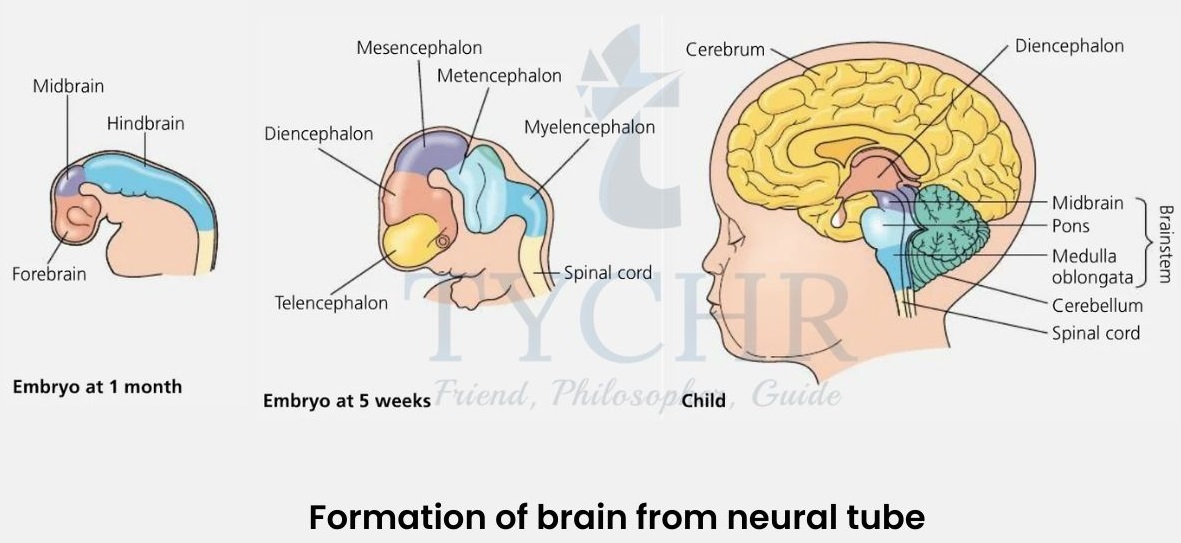
- Brain: A 1.4 Kg, neuron billionaire, non-identical, constantly changing, extremely complex structure.
- Controls and produces every emotion, thought, feeling, memory. Also the involuntary actions like cardiac heart-beat, peristalsis etc. are controlled by it.
Formation
- Its formation starts at the very first stage of embryo developing but competes at very
- The neural tube has two ends; Anterior end and Posterior end, which develops into forebrain and rest of the other parts of brain, respectively.
Neurons require high energy to communicate better, since half of the brain energy is consumed by communication between neurons. This energy is gained by glucose, delivered by the blood at a constant rate. As long as the glucose retains in the brain there will be high activity. The energy consumption is less in invertebrates and more in humans but even more in children or infants. |
Parts of the brain and related functions:
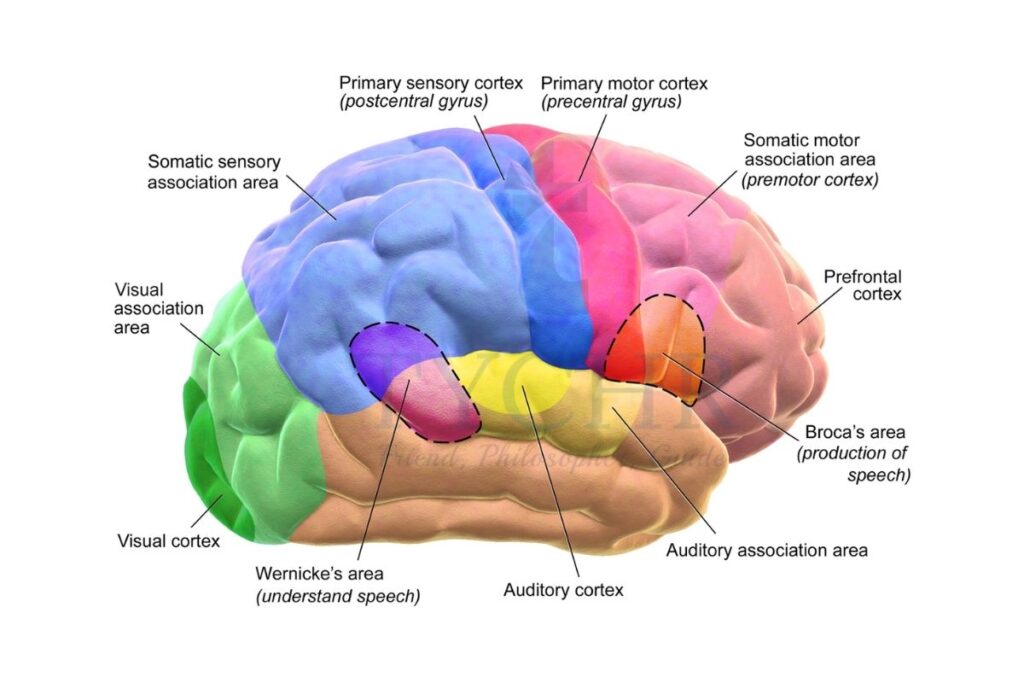
Nervous system-as a constituting organ
- Brain and spinal cord are parts of the CNS, the other parts are covered by PNS. The Peripheral system is further divided into SNS, ANS and ENS. Out of which ANS (Autonomic Nervous System) and ENS (Enteric Nervous System) respond to involuntary actions. ANS is located in medulla oblongata, regulates activities of certain glands and muscles.
- ANS is further divided into sympathetic and parasympathetic system.
Comparison
It’s response is important in emergency | It’s response is in returning back |
Response is “fight or flight” | Response is to “back and relax” |
Noradrenaline is the neurotransmitter | Acetylcholine is the neurotransmitter |
Excitatory or promoter | Inhibitor or suppressor |
Both the systems show antagonistic behaviour which can be seen in the diagrammatic picture:
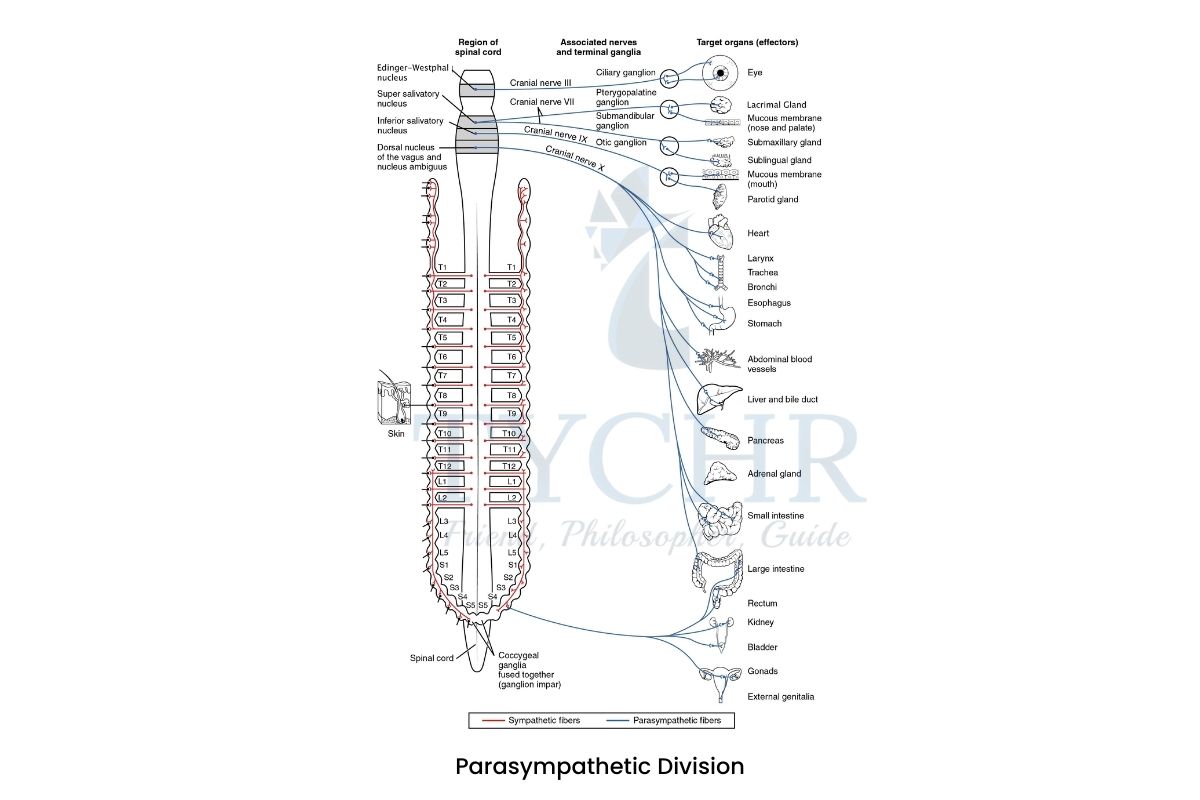
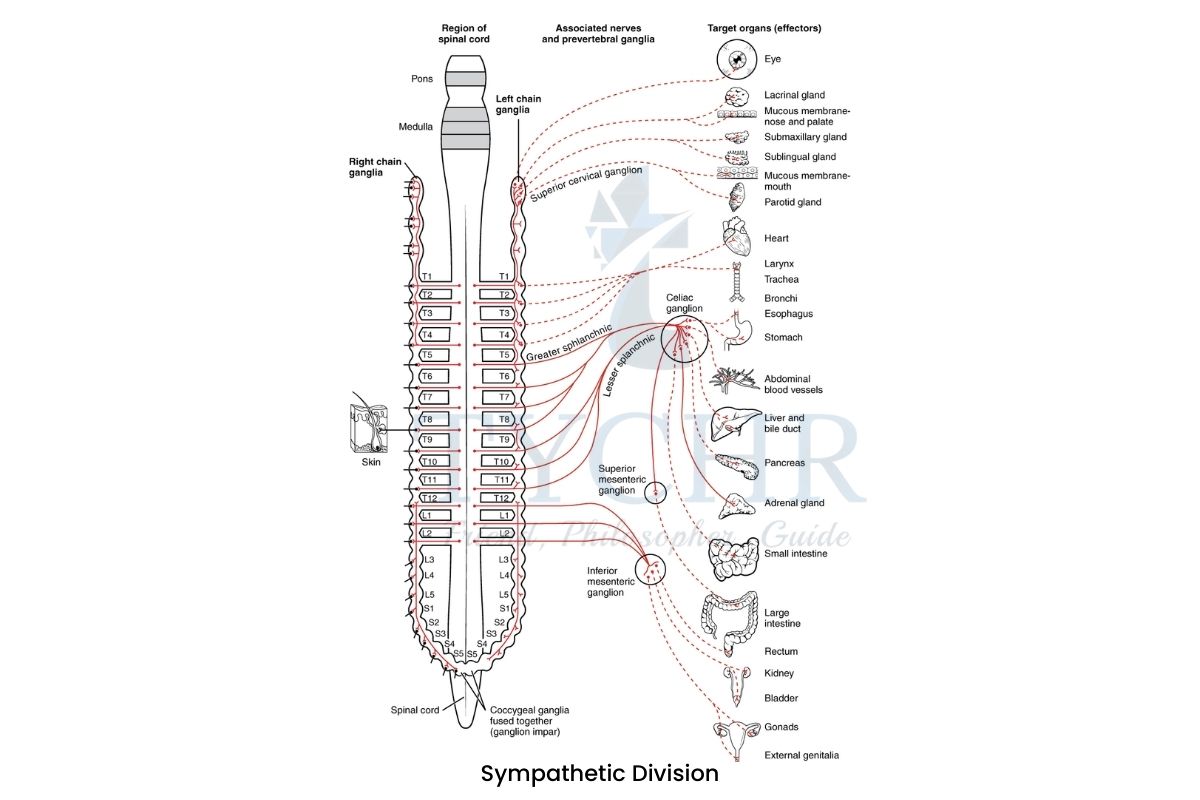
The Pupil reflex This is a cranial reflex, because it is concerned with the responses from the brain and more particularly, the ANS. The sensory and motor neurones connect in the brain which coordinates the relaxation and contraction of the pupil with respect to amount of light getting inside the eye from any external light source. |
Brain death
When a person shows no movements of extremities like legs and arms, no eye movement, absence of corneal reflex, absence of pupil reflex, absence of gag reflex, no respiration then the person is considered to be brain dead. The person in this state will never come to its senses at any costs i.e. he or she is completely dead. However, the heart can beat by providing artificial conditions because hear-beat is not completely dependent on the brain. Also, the spinal reflexes retains like knee jerk reflex response.
There are two medical tests which can assure the person is brain dead:
- Electroencephalogram (EEG): based on microvolts, shows lack of any activity if the brain is dead.
- Cerebral blood flow (CBF) study: an active isotope is inserted in the brain to measure the blood If no activity detected, the person is brain dead.
The cerebral cortex
- It covers the largest part of the mature brain e. cerebrum, formed from the front part of the neural tube.
- Grey matter, < 5mm thick, having 75% of body’s neuron.
- Performs response to various tasks such as language, thought, speech, visual processing, remembering, reasoning and motor movement.
- Increase in the size of the cortex promotes additional ability and advanced behaviour. Increase in size means increase in surface area, so to accommodate larger and larger surface area it tends to add folds rather than spread.
Interesting facts
|
Stimuli perceptions
Types of Receptors
- Mechanoreceptors
These are simulated by a mechanical force or any pressure like the sense of touch (externally), change in blood pressure in the arteries (internally). Proprioceptors present in muscle fibers can tell the position of our arms and legs. Pressure receptors in the inner ear tend to maintain our equilibrium. - Chemoreceptors
Responds to chemical substances, thus gives the taste and smell. It also monitors pH changes in blood vessels. The receptors which sense the pain (pain receptors) also comes under this. Olfactory receptors respond to smell and can detect 10,000 types of smells. - Thermoreceptors
Respond to change in temperature. These are present in the skin of the human beings. - Photoreceptors
Respond to light intensity. They are found in eyes of an individual, which constitutes rod and cone cells.
- All these receptors send messages to central nervous system, which process the signals are respond.
The human eye
A complex structure in the body that enables the vision in an organism.
Various parts and functions are shown as from outer to inner of the eye:
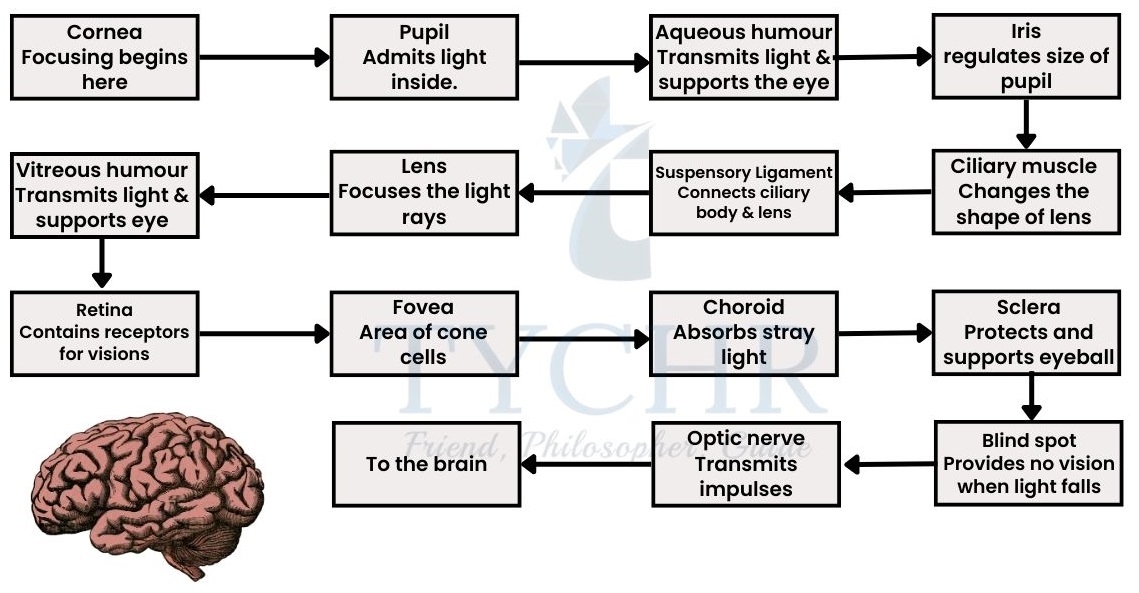
- Retina- Photoreceptor cells i.e. rods and cones are present here. Rod cells receives very dim light enables black and white vision while cone cells receives bright light, enables us to see colors. The light falls on this retina travels through ganglion cell layer, bipolar cell layer and then the receptors rod and cone cells which then transfer information through the nerve fibers to the brain.
- Colour blindness:
- This is an inherited disease caused by the deficiency of rod and cone cells in an individual.
- There are 3 types of cone cells code for red, blue and green colour which are the basic colours for making any visible colour, while rod cells makes us visible only black and white.
- Normal vision is trichromatic due to three variants of cone cells. But a colourblind person has dichromatic vision with either, blue and red cones or blue and green cones.
Where the stimuli perceptions are interpreted inside the brain?
- Broca’s area (speech center) discovered by Paul Broca, which has the ability to vocalize the words and Wernicke’s area discovered by Carl Wernicke, which has the ability to comprehend the speech.
- Each cerebral hemisphere of the cerebrum is responsible for one half of the body. The left cerebral hemisphere receives sensory input from sensory receptors on the right side of the body and the right side of the visual field in both eyes, and vice versa for the right hemisphere.
Human ear
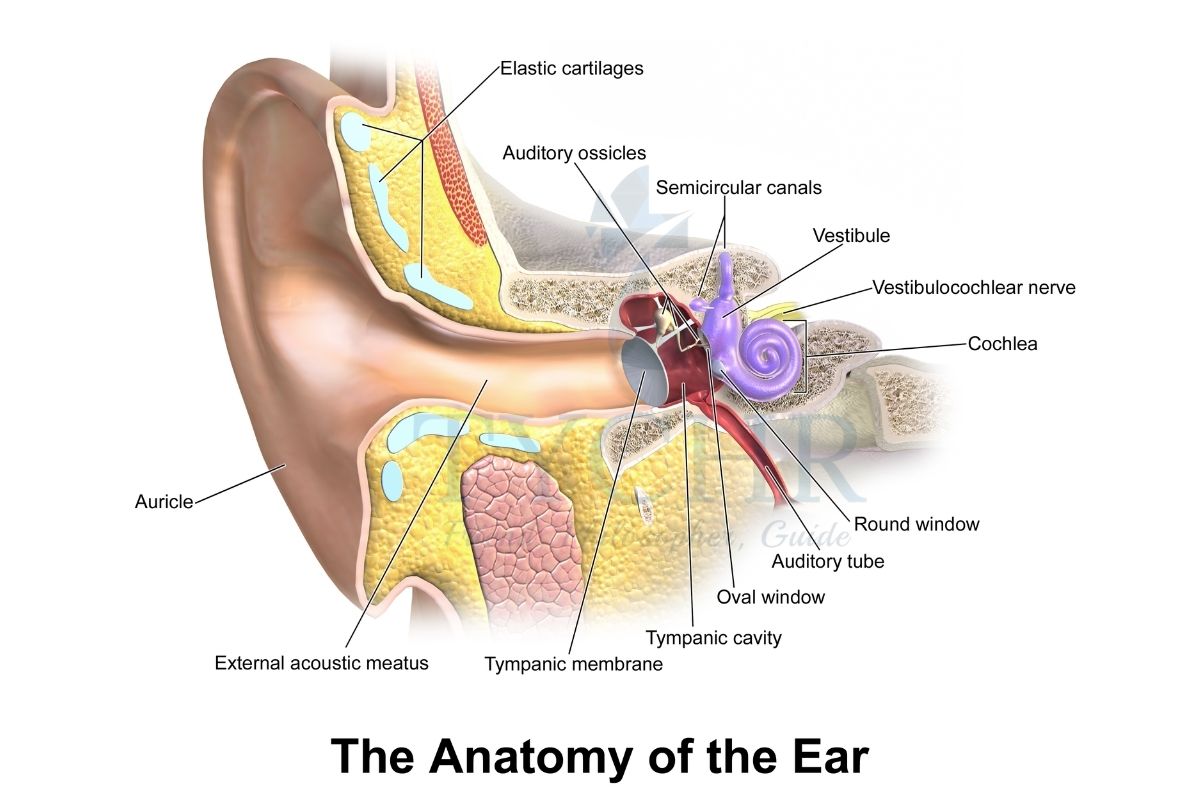
- Structures and functions of all parts of the ear:
- Pinna collects surrounding sounds are transfers them to auditory canal, which takes it towards the middle ear to the tympanic membrane (eardrum). It vibrates when receives sound.
- The bones in the middle ear, malleus, incus and stapes receive vibrational sound and amplify them up to 20 times.
- Vibrations then leave the middle ear and gets into inner ear, by stapes that hits the oval window and causes it to vibrate as well.
- The vibration is then passed to the fluid in cochlea (round window creates a pressure which makes it vibrate too), which further causes hair cells (mechanoreceptors) to vibrate.
- How we maintain balance?
- The semicircular canals help in maintaining the equilibrium. Fluid inside the canals move over the hair cells present inside them which detects the rotational movement of head.
- These hair cells send messages to vestibular nerve.
Cochlear implants Convert sound (received by external microphone attached) into electrical signals (deciphering the sound) that are picked up by auditory nerve and send to the brain.
Exam tip! In the answers of the questions from this chapter, there must have mentioned the co- relation of the concept/organ asked with nervous system, to have an effective answer. |
Innate and learned behaviour
Innate behaviour
- It is an inherited behaviour from parents and therefore has no influence of environmental factors in
- Sucking behaviour in human infants and grasping anything that touches their palm skin (palmar grasp reflex) are examples of innate Innate behaviour in invertebrates, are of two types; Taxis and Kinesis.
Taxis
- It is a directed response to a stimulus. These responses can be positive if the animal’s body is directed towards the stimulus and negative when it is directed away from the stimulus.
- Certain types of stimulus by which taxes can be identified are:
- Phototaxis – It is the response to light. The movement of animal away from the light is called negative phototaxis and towards the light is called positive phototaxis. Ex – Euglena exhibits positive phototaxis.
- Chemotaxis – It is the response to chemicals. Movement of the aquatic organisms to or from the chemicals dissolved in water tells their response towards the Ex- Planaria exhibits positive chemotaxis response.
- Gravitaxis – It is the response towards the gravity. The movement of organisms against or towards the gravitational pull can be determined.
- Rheotaxis – It is the response to the water current, whether the organism likes to flow with water current or tend to oppose it.
- Thigmotaxis – It is a response to touch. May be negative or positive thigmotaxis.
Kinesis
- It is response of an organism towards non-directional stimulus like some factor surrounding them such as humidity.
- The movement of the animal depends upon the intensity of the stimulus but not direction.
- The kinesis of the organism depends upon their movement speed and number of turns. If an environment does not suits the organisms, then they move rapidly but randomly, to somehow move to the suitable one. Or they turn more frequently while keeping up the slow pace.
- The movement speed in response to stimulus is called orthokinesis and the slow or rapid turns the organism make, is called klinokinesis.
- Ex – When a woodlouse is transferred to damp conditions from the dry conditions, the they move slowly but with much more frequent turns.
Learned behaviour
- It is not genetically inherited but develops as a result of experience by time.
- It is dependent on the environmental factors among which the organism inhabits.
Imprinting
- It is a rapid learning process by which an organism develops attraction and recognition of another moving object regardless of the consequences.
- First ethologist, Konrad Lorenz put out this term and concept after experimenting on the goslings.
- He hatched some goslings in an incubator and put himself as the first moveable thing they see. The goslings imprinted on him and followed him everywhere he goes.
- Then in a follow-up experiment to prove this imprinting, he attached a box with a moving model train and found that goslings had imprinted on the box and starts to follow it.
- He concluded that, an animal imprints once in its lifetime and mostly at early stage (critical stage).
Operant conditioning
- This concept of learning was put forward by B.F. Skinner in 1930s.
- It creates an association between behaviour and its consequences for an animal.
- Ex – If an animal once encountered with something dangerous, it would not dare to take the risk again.
Learning
- It can be explained as a change in performance that is stored in the nervous system as memory.
- Example – Birdsong by different bird species or by birds of one species is partly innate and partly learned activity. Birds have inherited aspects of singing which is stimulated by listening to their parents and practising it. Singing is the speciality of male birds to call female for mating.
Birds have crude template in its early phases which is stimulated by hearing to the voice of their parents (father) and eventually matches with the song heard.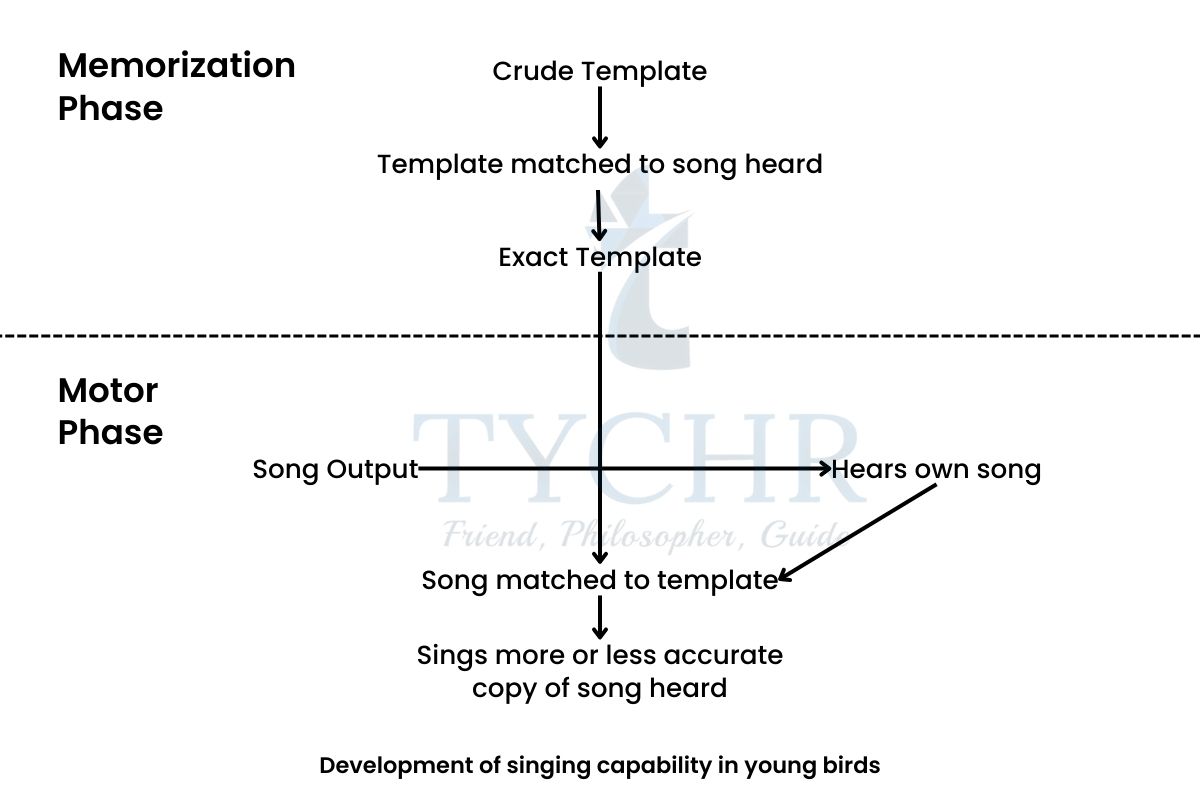
Figure 12.5 Development of singing capability in young birds
Memory
- It is the process of encoding the information, storing it and then accessing it while putting into use.
- Encoding of the information is done by the brain in a form that is to be stored.
- Storing the information in some form helps us to retain it for some period of time. It may be short term or long term.
- Short-term memory (SLT) – The information which is stored in for a short period of of time.
- Long-term memory (LTM) – The information which is stored in or a longer period of of time.
- Accessing the stored information is the retrieval of memory (STL or LTM). It is achieved by two methods; recognition (any physical object or event that relates with something already experienced) and recall (remembering the object, event or incident happened before and not present now).
Neuropharmacology
Neurotransmitters
- These are the chemicals made by neurons which act as message to transmit to the respective neuron.
- Neurons communicate through synapses using neurotransmitters which are released from presynaptic membrane into synaptic cleft and received by a specific receptor molecule in postsynaptic membrane of the other neuron.
Types of neurotransmitters (NTs) according to the responses they show; excitatory and inhibitory neurotransmitter.
- Excitatory neurotransmitter: This kind of neurotransmitter, when released into the synaptic cleft increases the permeability of postsynaptic membrane to take up the positive ions (Na+ ions). It causes depolarization and an action potential is generated above the threshold, therefore carries the impulse along the neurone.
Ex – Acetylcholine - Inhibitory neurotransmitter: This kind of neurotransmitter causes postsynaptic membrane to either lose positive ions (K+) or diffuse in negative ions (Cl–). It causes hyperpolarization (more concentration of negative ions inside the membrane) which causes difficulty in generating an action potential up to the threshold.
Ex – GABA (gamma-aminobutyric acid)
Summation
It involves both the excitatory and inhibitory responses on a postsynaptic membrane at a time. It the sum of signals comes out to be excitatory then the impulse is carried forward but if it is inhibitory then the impulse is not carried forward. - Types of neurotransmitters (NTs) according to the rate of activity; slow-acting NTs and fast-acting NTs.
- Fast-acting NTs – These take less than 1 millisecond to act on the postsynaptic membrane.
- Slow-acting NTs – These takes hundreds of milliseconds or up to minute to have effect on the postsynaptic membrane.
- These are also called neuromodulators because they have the ability to modulate fast-acting NTs. They regulate efficiency of releasing and receiving neurotransmitter from presynaptic and by postsynaptic membrane respectively.
What makes slow-acting NTs slow?
It is a two-step process. Neurotransmitter acts on a secondary messenger which further opens the gates of postsynaptic membrane. While in fast-acting NTs the neurotransmitter directly binds to the receptor molecule which stimulates the diffusion of Na+ ions into the membrane through ion-gate.
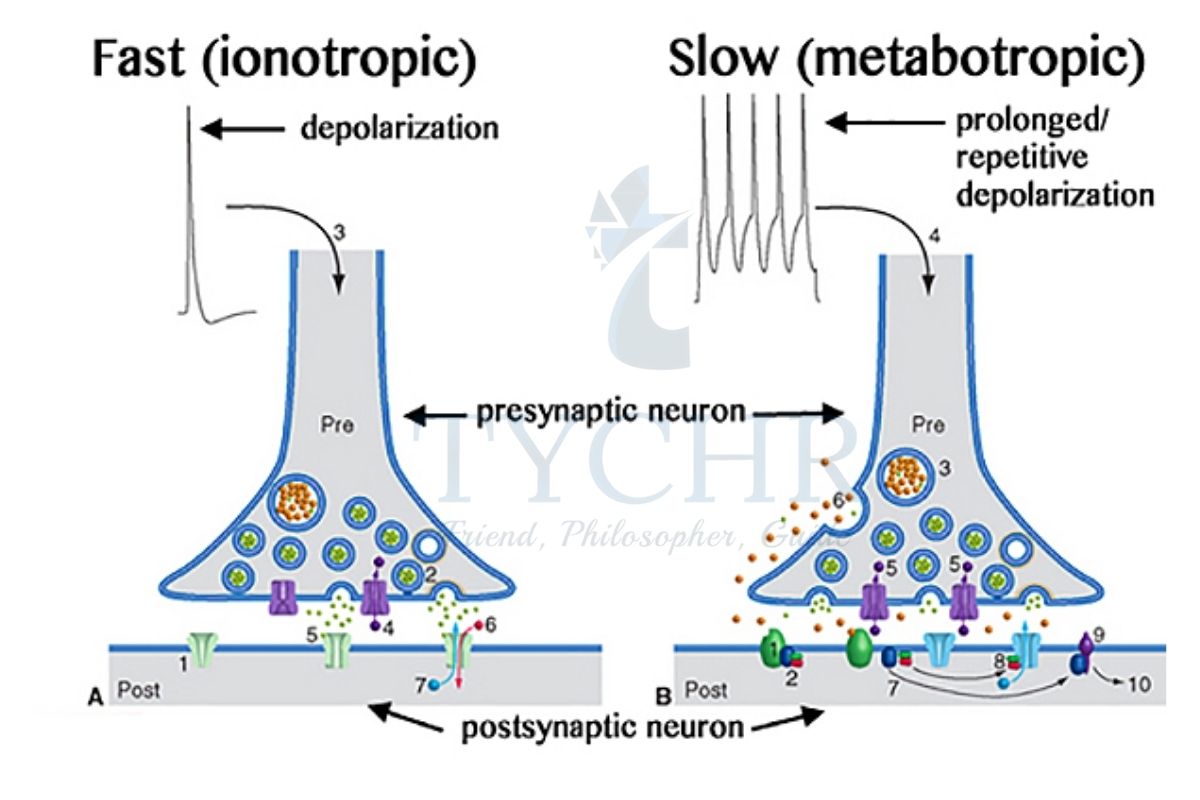
Memory and learning – as offered by slow-acting NTs
- Slow-acting NTs plays their role in learning and memory. They release secondary messenger which binds on the receptor molecule to modify them or to increase the ion movement through ions gate channel embedded in them. It results in the short-term learning.
- If the secondary molecules retains on the receptors for a longer period then they reach the nucleus and activates transcription. New proteins are made which modifies the shape of the synapse and further changes its This creates a memory.
Psychoactive drugs
- These drugs affect the post-synaptic transmission and thereby alter the functioning of these synapses.
- Excitatory drugs (like nicotine, amphetamines and cocaine) will increase the post- synaptic transmission while inhibitory dugs (like tetrahydrocannabinol (THC), benzodiazepines and alcohol) decrease the post-synaptic transmission.
Stimulants (excitatory drugs)
- Stimulants increase the activity of the nervous system. This stimulation is just as provided by sympathetic nervous system.
- Nicotine calms the brain by causing the release of dopamine which gives feeling of pleasure.
- Cocaine causes over release of dopamine in the synapses which leads to the over stimulation of post synaptic membrane and therefore causes euphoria.
- Amphetamine causes release of dopamine and noradrenaline in the synaptic cleft that leads to alertness, activeness and euphoria.
Sedatives
- Benzodiazepine (diazepam) modulates the activity of GABA and makes the postsynaptic membrane hyperpolarized by binding GABA to the receptor. It helps in reducing anxiety, prevents panic attacks and insomnia.
- THC – tetrahydrocannabinol is the chemical present in the marijuana (cannabis). It binds to the cannabinoid receptors present in various parts of the brain. It is also an inhibitory neurotransmitter, which causes polarization of post-synaptic neurons.
Drug addiction
- It may be defined as the cravings and intake of the drugs again and again due to lose of control of
- Some reasons for the drug addiction may be:
- Genetic predisposition
It is based on the gene which is responsible for dopamine receptors. The amount of dopamine release in an individual can tell the amount of alcohol it may take. - Social factors
Peer pressure, family problems, social derivation, poverty etc. have great influence on people to be addicted to drugs. - Dopamine secretion
Chemical drugs like opium, cocaine, nicotine and alcohol make the release of dopamine and the release of dopamine gives the pleasant feeling. This makes it very difficult to restrain.
- Genetic predisposition
Anaesthetics
- These are the molecules that can block the sensory reception and causes loss of sensation in any part or the whole body.
- Local anaesthetics numb a localized area or body part while general anaesthetics are inhaled and thus affect the whole body.
MDMA (Ecstasy) MDMA is a synthetic molecule which causes the extra release of serotonin (it offers pleasure feeling). The SERT receptors (serotonin receptor) here play a great role. When serotonin is released by one neurone, the SERT will pump back the extra serotonin. When the SERT performs its act, the pleasure feeling is replaced by depression. When by increasing intake of MDMA causes depletion in serotonin levels, the dopamine enters the SERT and causes neurotoxicity. |
Ethology
Introduction
- The study of animal behaviour in natural conditions is called ethology.
- Animals behave in response to external stimuli and in artificial captive conditions those stimuli may be different from natural habitat. Therefore this study occurs in natural This is the marking difference between ethology and psychology.
- Natural selection also influences the animal behaviour. Because as the organism evolves accordingly, the actions and interaction will change in order to survive.
Examples of influence of natural selection on animal behaviour
Synchronized oestrus
- In lions, there is always the competition between the male lions in order to take the pride and the female lion to have their own cubs.
- Once the cubs are born, if any other male lions wants to take the pride then he fights with the father of the cubs and if won they may kill the cubs.
- To prevent this, all the female lions come into oestrus at the same time. This makes them save each other’s cubs and even lactate them when one is going for Thus increases the chances of survival for the suckling cubs.
Parus major
- A bird species, which used to feed their little one with small insects and And the availability of food rises in spring.
- Due to global warming the spring season now arrive earlier that it did before. This made the birds evolve in such a manner that, they now breed a bit earlier than they used So that to cop up with the environmental strategies for survival.
Blackcap migration
- Sylvia atricaplia is the bird species which migrates to Spain in winter and breed in Germany in summers. But the change is behaviour was observed in mid 20th Some birds started to go to Britain (UK) instead if Spain to spend their winters.
- Britain is nearer than Spain. And due to global warming the extreme cold winter temperature in Britain falls and matches with the blackcaps’
- An experiment was conducted by collecting the eggs from both the different habitats and when the eggs hatched the direction of flying of the warblers were They tend to flew in the directions they were collected from.
- It was also noted that the Britain birds arrive 10 days earlier than Spain birds and thus have the advantage of taking the territories.
- This behaviour was inhabited And the cause was the environmental.
Vampire bats
- They show behavioural pattern of altruism. A vampire bat feeds and when comes to their habitat, they regurgitate blood for those who did not feed.
- The sharing of blood happens between not only family members but to unknowns as Also it is not a cooperation but genuine altruism.
- If vampire A has given its blood to B and some other night, B will return the This increases the chances of survival for all of them.
Blue tits and the cream Blue tits Cyanistes caeruleus as learned the activity of pecking through the aluminium caps for the milk cream. It was observed in 1920s in England. This behaviour spread rapidly in many areas even 150 km away. The habits were noticeable because of humans around. It was observed that, when no milk bottles are now ben delivered on doorsteps and all people are buying from supermarkets. The tits have no chance of having cream but this did not make any difference. The tits eventually lose their habits of having cream. This was the solid proof that it was their learned behaviour but not innate. |

